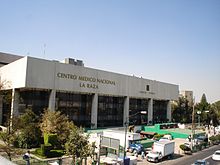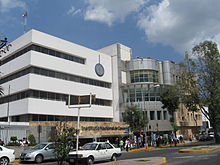Health System of Mexico
The Mexican health system includes public and private institutions, as well as private doctors. Health care services are all traded on the open market, so these are reserved for those who can afford them. This also applies to doctors who work in their own practice or in a clinic. On the other hand, a sophisticated care process has ensured that a large part of the Mexican population receives medical care since 2012. At the end of 2013, there were 4,466 hospitals in Mexico .
history
Hospitals first appeared in Mexico in the early 16th century, including those that were exclusive to the indigenous population. Some were founded by the Crown, others were privately donated, but most of them by the Catholic Church. Bishop Vasco de Quiroga founded hospitals in Michoacán in the 16th century. In Mexico City, the conqueror Hernán Cortés founded the Hospital de Jesús Nazareno for Indians, which still functions as a hospital today. The Hospicio Cabañas in Guadalajara , Jalisco , Mexico opened in 1791. This facility is still in operation and is now a UNESCO World Heritage Site . This hospital is one of the oldest and largest in Latin America . The purpose of the foundation by the Bishop of Guadalajara was to offer the functions of a workhouse , hospital , orphanage and poorhouse under one roof.
The Mexican health program IMSS was established in 1943 during the presidency of Manuel Avila Camacho . In the early 1990s, it became clear that Mexico was now in a transition stage in the health care of the population. Compared to 1940 or 1970, Mexico in the 1990s had visible mortality numbers more in line with a developed country. During 2009 swine flu , the WHO director said Mexico was responding in an exemplary manner. By this he meant fast and transparent reporting, good control measurements and generous provision of data and samples. The CDC flu director Nancy Cox also spoke of a worldwide reaction from Mexico.
The Center for Research and Development in Health Sciences in Monterrey was founded in 2009.
Private health care
Around two-thirds of Mexico's 2,988 hospitals are private, but less than 10% of the Mexican population has adequate insurance, so a large proportion of the population has to pay for these services privately.
State health care
State health care is provided through an extensive system by the Mexican government. It is available to all Mexican citizens under Article 4 of the Mexican Constitution. The supply is partially or fully subsidized by the state, depending on the employment relationship (Spanish: derechohabiente's). All Mexican citizens are generally entitled to subsidized health services from the facilities of the state Secretaría de Salud (comparable to a health ministry), regardless of their employment relationship.
The Secretaría de Salud provides care to all Mexicans who do not have formal employment. This program serves over 55 million people. However, citizens in an employment relationship and the people who depend on them are also entitled to use the state aid programs. The IMSS program is financially based on three pillars: employees, employers and the state. About 58 million Mexicans are insured through the IMSS.
The IMSS is not responsible for public sector employees. These are insured by the Instituto de Seguridad y Servicios Sociales de los Trabajadores del Estado (ISSSTE, German: Institute for Social Security and Services for State Employees). It is responsible for all health and social services to government employees at local, regional and national levels. Almost 13 million people fall under the jurisdiction of ISSSTE. The governments of the states in Mexico also have their own health programs independently of the programs of the Mexican federal government. In most states there are free or partially subsidized services for the citizens of the respective state. The Secretaría de Salud is the largest public health institution in the country, with 809 hospitals across Mexico. The IMSS guarantees the employed citizens and their families hospital care in the associated 279 hospitals. The ISSSTE guarantees government employees care in its 115 hospitals. The remaining 279 hospitals in Mexico belong to the state institutions, the Secretaría de la Defensa Nacional (Ministry of Defense), the Secretaría de Marina (Navy), the petroleum company Petroleos Mexicanos, and the Red Cross. The state hospital infrastructure must cover 1.973 million km². Accordingly, the public supply also consists of an extensive network of many small hospitals. Over 50% of these public institutions have fewer than 50 beds.
statistics

Statistics show that Mexico's health system has improved a lot since the 1970s. However, in an OECD comparison, Mexico lags behind in terms of both health levels and the availability of care.
Life expectancy development in Mexico over time
| Period | Life expectancy
in years |
Period | Life expectancy in
Years |
|---|---|---|---|
| 1950-1955 | 50.7 | 1985-1990 | 69.9 |
| 1955-1960 | 55.3 | 1990-1995 | 71.9 |
| 1960-1965 | 58.5 | 1995-2000 | 73.7 |
| 1965-1970 | 60.3 | 2000-2005 | 74.9 |
| 1970-1975 | 62.6 | 2005-2010 | 75.7 |
| 1975-1980 | 65.3 | 2010-2015 | 76.5 |
| 1980-1985 | 67.8 |
Source: UN
Efficiency and Affordability

United States residents who live close to the Mexican border are increasingly crossing the Mexican border for medical care. Popular treatments include dental care and plastic surgery. Dental treatments in Mexico often cost only about 20 to 25 percent of treatments in the United States, while other medical services in Mexico cost about a third.
General health insurance
On December 1, 2006, the Mexican government created a new health insurance program for a new generation. This was followed by President Felipe Calderon's health care announcement on February 16, 2009, in which he stated that if the country continued to make progress, general health insurance could be financed from 2011 onwards. General health insurance for pregnant women was announced on May 28, 2009, and general health insurance for everyone was introduced in August 2012.
Social influences
Social determinants of health in Mexico are factors that affect health levels in certain population groups. These factors consist of the conditions in which people grow, live, work and age. The inequality of health levels in the population groups is influenced by social factors. In the last decade, Mexico's health system has made great strides, as access to services in the health sector has increased significantly. The death rate has also decreased. However, the health system still shows large inequalities and the level of health is still determined by social factors.
See also
Individual evidence
- ↑ Mexico achieves universal health coverage, enrolls 52.6 million people in less than a decade . Harvard School of Public Health. August 15, 2012. Retrieved September 16, 2013.
- ↑ a b Global Health Intelligence.
- ^ David Howard: The Royal Indian Hospital of Mexico City. Arizona State University Center for Latin American Studies, Tempe 1979, Special Studies 20.
- ↑ Carmen Venegas Ramírez: Regimen hospitalario para indios en la Nueva España.
- ^ Josefina Muriel: Hospitales de la Nueva España. 2 volumes.
- ↑ Mexico's health care lures Americans.
- ^ Health Care and Social Security.
- ^ Mexico Wins Praise for Swine Flu Response.
- ^ A b Mexican National Statistics Institute: INEGI.
- ↑ Quienes Somos. ( Memento from July 21, 2009 in the Internet Archive )
- ^ National Health Information System, DGIS - SALUD.
- ↑ Country profile: Mexico (PDF)
- ↑ World Population Prospects - Population Division - United Nations. Retrieved August 6, 2017 .
- ^ A b Philip J. Hilts: Quality and Low Cost of Medical Care Lure Americans to Mexican Doctors. In: The New York Times. November 23, 1992.
- ↑ Manuel Roig-Franzia: Discount Dentistry, South of The Border. In: The Washington Post. June 18, 2007.
- ↑ Mexico achieves universal health coverage, enrolls 52.6 million people in less than a decade. August 15, 2012, accessed January 27, 2016 .


